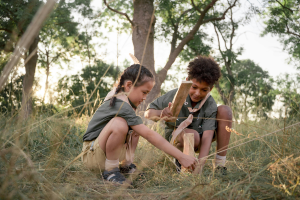The Importance of (Not Just Visual) Interaction With Nature: A Study With the Girl Scouts
Citation
Gray, C. E., Kahn Jr, P. H., Lawler, J. J., Tandon, P. S., Bratman, G. N., Perrins, S. P., & Boyens, F. (2025). The importance of (not just visual) interaction with nature: A study with the Girl Scouts. The Journal of Environmental Education, 1-18. doi.org/10.1080/00958964.2024.2436166
 Do you remember climbing a tree as a child? Or playing in a stream? Whether you realized it or not, these experiences made you more connected with nature. For children to care about nature, they must interact with it. Nature interactions can be put into two different categories. First, there are visual interactions. These only use the sense of vision. Next, there are embodied interactions. The examples above are embodied interactions, where many senses are engaged and the body is in motion.
Do you remember climbing a tree as a child? Or playing in a stream? Whether you realized it or not, these experiences made you more connected with nature. For children to care about nature, they must interact with it. Nature interactions can be put into two different categories. First, there are visual interactions. These only use the sense of vision. Next, there are embodied interactions. The examples above are embodied interactions, where many senses are engaged and the body is in motion.
A 2025 study led by Carly E. Gray, PhD, examined how different interactions with nature impact feelings of Presence. Presence is defined as feeling high awareness and connection without thought. Presence can occur at varying lengths and levels. Feeling Presence can improve aspects of well-being and health (Pritchard et al., 2020). Gray’s study looked at children ages 8-11 participating in Girl Scouts. Researchers gathered 126 stories by Girl Scouts describing a recent meaningful nature interaction. Participants also filled out a survey on feelings of Presence. The study questioned if embodied interaction with nature matters. More specifically, it looked at whether Girl Scouts who had embodied interactions experience a greater amount of presence.
Researchers identified common patterns of nature interaction using coding. They defined them as visual or embodied. For example, “looking at a mountain view” would be only visual. Alternatively, “building a fort” would use many senses. Then, they looked at the surveys to see which types of interactions were associated with Presence. The results showed Girl Scouts who reported at least one embodied interaction with nature experienced a greater amount of Presence.
These results may influence environmental education going forward. One way is to incorporate more embodied interaction in lesson plans. Smelling flowers or hugging a tree can help connect youth to something bigger than themselves. Looking at pictures of nature may not have the same effect. Kids should directly connect with nature to encourage appreciation of the environment and experience more Presence.
Abstract
 This study investigated whether children’s nature interactions that are embodied (versus only visual) would be associated with a state of being highly aware without thought, including being in “the present moment,” and/or feeling connected to something beyond the self. We refer to this state of being as Presence in nature. Using an interaction pattern approach, we coded written narratives from 127 Girl Scouts (8-11 years old) about a recent meaningful nature experience and, through a questionnaire designed for the study, assessed the degree to which participants experienced Presence in that nature experience. Exploratory analyses indicated that participants who enacted embodied interactions with nature (e.g., “making snowman,” “wrapping arms around tree,” “talking to chickens”) reported a greater sense of Presence in nature than participants whose interactions relied solely on vision (e.g., “seeing snow,” “seeing moss,” “watching pileated woodpecker”). Discussion focuses on the implications of Girl Scouts’ embodied nature interactions for environmental education.
This study investigated whether children’s nature interactions that are embodied (versus only visual) would be associated with a state of being highly aware without thought, including being in “the present moment,” and/or feeling connected to something beyond the self. We refer to this state of being as Presence in nature. Using an interaction pattern approach, we coded written narratives from 127 Girl Scouts (8-11 years old) about a recent meaningful nature experience and, through a questionnaire designed for the study, assessed the degree to which participants experienced Presence in that nature experience. Exploratory analyses indicated that participants who enacted embodied interactions with nature (e.g., “making snowman,” “wrapping arms around tree,” “talking to chickens”) reported a greater sense of Presence in nature than participants whose interactions relied solely on vision (e.g., “seeing snow,” “seeing moss,” “watching pileated woodpecker”). Discussion focuses on the implications of Girl Scouts’ embodied nature interactions for environmental education.